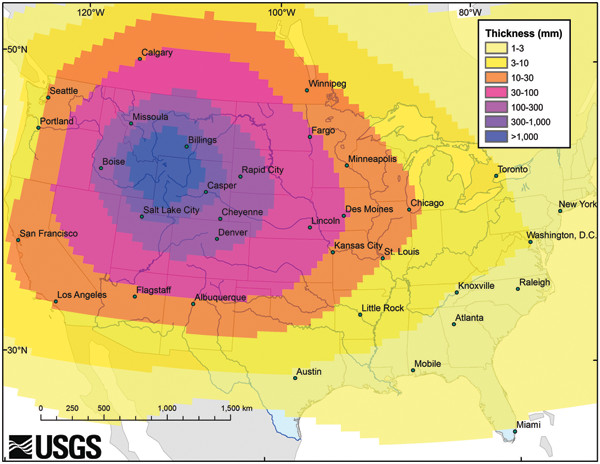
by Mary Caperton Morton Tuesday, December 9, 2014

How Yellowstone ash could spread across the U.S. Credit: USGS.
In the event of another super-eruption at Yellowstone National Park, few places in the U.S. would be ash-free, according to a new modeling study. The northern Rocky Mountains would be blanketed in meters of ash, and millimeters would be deposited as far away as New York City, Miami and Los Angeles.
The study, published in Geochemistry, Geophysics, Geosystems, was a test run for a new U.S. Geological Survey (USGS) model called Ash3D, which incorporates data on historical wind patterns to calculate ash-fall thicknesses for potential volcanic eruptions. The work provides the first quantitative estimates of the thickness and distribution of ash in cities around the U.S. if the Yellowstone volcanic system were to experience another event like those that occurred about 2.1 million, 1.3 million and 640,000 years ago. The most recent eruption at Yellowstone was about 70,000 years ago; most scientists agree that another eruption is unlikely to take place anytime soon.
The model also helps explain some of the fallout from past Yellowstone eruptions, which is inconsistent with the prevailing westerly winds that sweep across the country. “In essence, the eruption makes its own winds that can overcome the prevailing westerlies, which normally dominate weather patterns in the United States,” said Larry Mastin, a geologist at the USGS Cascades Volcano Observatory in Vancouver, Wash., and lead author of the new study, in a statement. “This helps explain the distribution from large Yellowstone eruptions of the past, where considerable amounts of ash reached the West Coast.”
© 2008-2021. All rights reserved. Any copying, redistribution or retransmission of any of the contents of this service without the expressed written permission of the American Geosciences Institute is expressly prohibited. Click here for all copyright requests.